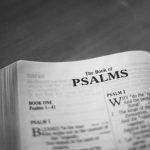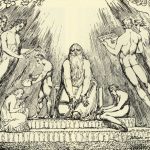This is a copy of my final exam write up for my Biblical Interpretation class. I was asked to analyze Isaiah 6 and its usage in the NT.
Isaiah 6
Isaiah 6’s genre is a prophetic judgment speech against Israel. It also includes a woe oracle against Israel in 6:5 for being of unclean lips. As is typical with the prophetic genre, YHWH’s speech is in the form of poetry in verses 9-13. Typical also for prophetic judgment is the hope of restoration which is found in verse 13; the “holy seed/offspring” which will survive the destruction. The passage can also be described as proto-apocalyptic. The heavenly court scene is frequently found in apocalypses as is the idea of unavoidable calamity. There exists also a dichotomy between the unrighteous who are marked for destruction and the righteous who will survive. From a literary standpoint, the written record of this prophecy invites the reader to become part of this elite group who do listen and see and survive the destruction. This motif is also picked up on in the Gospels and will be discussed below.
Isaiah prophesied from ~740-700BCE but this passage specifically mentions the vision occurring in the year of King Uzziah’s death. Uzziah did what was right in the sight of YHWH but he failed to put a stop to idolatrous worship in high places (2 Kgs 15:3-5). He also led Israel to many military victories (2 Chr 26:6-16) but this led to him becoming proud in his heart and committing ma’al, unfaithful encroachment upon cultic holiness when he entered the Temple to burn incense upon the altar of incense. The irony is not lost on Isaiah who has a vision of a heavenly Temple filled with smoke and has a burning coal used to cleanse his mouth, most probably from the altar of incense as this is the closest altar to the throne room, the Holy of Holies. As a result, Uzziah is stricken with leprosy until the day of his death, which renders him unclean and he is no longer able to function publicly as king. His son Jotham becomes co-regent and is not a good king, thus creating a time of great uncertainty in the kingdom. At the same time, the Assyrian kingdom begins to threaten Judea, thus Uzziah’s death designates the end of an age of stability for the kingdom.
The fact that YHWH gives a command for Isaiah to prophesy in order that the people’s understanding be dulled and their hearts hardened has bothered many commentators, but given the context of Isaiah 6 within the canonical book of Isaiah, it makes sense. In Isaiah 1, the people are not acknowledging YHWH as their master. Instead of acting with righteousness and justice, they simply intensify their religious observances of sacrifices and festivals thinking that these types of actions will deliver them from the desolation rather than proper action. God declares in Isa 1:27 that Zion’s “repentant ones” will be redeemed with righteousness and justice and yet when we get to Isa 5:7 we see that rather than practicing righteousness (tzedakah) and justice (mishpat), YHWH looked and beheld bloodshed (mishpach) and an outcry (tze’akah) (a play upon Hebrew words). Thus, the sealing up of the people’s hearing so that they will not repent is because their judgment is sealed because of their wickedness and YHWH will not redeem them.
Isaiah’s vision begins with a proto-apocalyptic view of the heavenly court. The use of the Hebrew word הֵיכָל is not the common term for the Temple but is a rare word of Mesopotamian origin. It is used to indicate either the palace of a king (Isa 39:7) or the Temple (Isa 44:28), but in this passage, it is ambiguously used for both; the Temple is the palace of King YHWH. The fact that there is a vision of YHWH enthroned immediately after the announcement of the death of King Uzziah serves to alleviate the distress of Uzziah’s death and the transition to a less-than-righteous king. By seeing YHWH on the throne, Isaiah and the audience are assured that YHWH is still king regardless of which human sits upon the throne of Israel. The NASB translates that the “train of His robe” filled the Temple but garments of that era did not have trains, they typically ended between the knees and feet of the wearer. The Hebrew שׁוּל indicates the edge of the garment and is most likely in reference to the hem of His garment which would contain tassels. In the ancient Near East (ANE), the hem of a person’s garment could play a legal role by symbolically and legally representing a person and could be used in lieu of a signature by pressing one’s hem into a clay tablet. The fact that the hem of YHWH’s robe fills the Temple graphically represents His power and majesty. It was also a practice in the ANE to seize hold of the hem of the garment of a god or king as an act of submission, thus the fact that YHWH’s hem is still visible hints that there is still the possibility of Israel submitting to YHWH and restoring the relationship.
The normal throne room creatures for YHWH are keruvim and yet in this vision, Isaiah sees seraphim;, snake-like creatures with wings. Seraphim brings the imagery of disobedient Israel in the desert who are plagued with serpents (seraphim) and thus serves as a proper image for judgment. Isaiah hesitates in the presence of grandeur because, like Moses, he feels a sense of unworthiness in the area of speech. One of the seraphim flies to Isaiah with a coal from the altar (again, from the altar of incense due to its proximity to the throne and thus no connotation of animal sacrifice) and cleanses Isaiah’s lips from sin. Isaiah’s iniquity is taken away and his sin is purged, כפר. The use of the verb כפר also is used in Akkadian rituals referring to the “wiping” away of ritual impurity and is specifically used in describing the purification of the mouth of the bārû or incantation priest in preparation for presentation of divine will. Thus, this scene shows that Isaiah’s mouth is prepared to deliver a true word from God in the midst of a people who are impure. Zephaniah 3:9 picks up on the idea of the people having “unclean lips” when he prophesies that one day YHWH will give the people purified lips in order that they may call upon the name of YHWH. The impurity of sin is a massive and objective reality which prevents people from hearing the voice of God and it is only after this impurity is removed that Isaiah can finally hear the voice of God (Isa 6:8).
YHWH judicial decree against Israel to have ears that cannot listen, eyes that cannot see and hearts that cannot understand uses language that elsewhere is used to mock lifeless idols! Thus the people are becoming lifeless like the idols that they have chosen to worship. God is not depicted here as a cruel master who refuses repentance, these people have already been given plenty of chance. It is very reminiscent of the days of Noah where the people were given over 100 years to repent but once the rain started to fall, the doors of the Ark were sealed up and there was no chance to escape the judgment; only those who were the faithful remnant before the rains of judgment fell were spared. The desolation in Isa 6:11 parallels the level of destruction caused by the floods, albeit on a local level. The “tenth” that survive the destruction recalls the tithing commandment that a tenth part of the produce of one’s field belongs to YHWH. So too, a tenth of the people still belong to YHWH and thus are preserved.
NT use of Isaiah 6
Matthew 13:14-15 quotes Isaiah 6:9-10 as part of Yeshua’s response to his disciples asking him to explain the parable of the sower. Yeshua teaches this parable after many of the cities (Matt 11:20) and leadership reject his message. While this narrative is part of the historical gospel genre, it is also apocalyptic as it presents a dichotomy between those who will hear the word and will yield a crop and those who do not and will die out. As in the original passage of Isaiah, only the disciples and the reader are privy to the understanding of the parable marking them out as part of a righteous remnant. This information should not be seen as a redactional addition to the text in order to explain the failure to bring the message of Messiah to the majority of Jews, rather it should be viewed as part of the ongoing struggle of God with Israel to listen. Yeshua’s application of this gives us indication that Isaiah 6 is not a redactional insertion only produced after the refusal of Israel to receive Isaiah’s message as some have proposed. Thus, it is an appropriate use of this OT passage by Yeshua because it is part of the history of Israel’s (and humanity’s) hard-heartedness. This verse could also be continually applied even to this day as there are many who own bibles and even read their bibles, yet they do not hear the voice of God calling them to repent and change their ways; they are not prepared to commit themselves to following the Scriptural Yeshua as his disciples and live their lives according to his model, instead turning to putting their hope in religious rituals of the modern church for their salvation.
The usage of Isaiah 6 fits the context of the parable that Yeshua tells about the sower. Both the parable and Isaiah 6 predict that only a few will actually receive the message and react properly. The unique verb anaplēroō (rather than merely plēroō), meaning “to completely fulfill” the prophecy in question is used to show that the rejection of Yeshua’s message will be the greatest fulfillment of Isaiah’s prophecy in a series of fulfilments (which I would argue continues on to this day). Like the greater context of Isaiah has shown, Yeshua’s use of parable-speak confirms that his opponents have freely chosen to reject the message since they too could have come to Yeshua and asked the meaning of the riddle. It is also important to note that in Matthew this is the first parable and thus sets the precedent that the usage of parables is not intended to better explain a concept, but is actually intended to mask the meaning from an unintended and rebellious audience.
Mark’s usage of Isa 6 is shorter but still within the same context as Matthew’s of the parable of the sower. While Mark’s version of the Isaiah quote is shorter, he does go into a longer explanation of the parable afterward which indicates that he is more focused on Yeshua teaching his disciples the mystery rather than condemnation of those who do not hear.
Luke 8:10 quotes Isaiah 6 even shorter than Mark and does not include the part about the audience having the ability to return and be healed if they could just understand. Luke’s Yeshua shows a concern for this specific parable not being understood rather parables in general and his focus upon the general response that the gospel demand. There is no questioning of his disciples as to why they do not understand as in Mark.
John uses this quote twice but in a very different context than the synoptic gospels. In John 9:39-41, Yeshua alludes to Isaiah’s passage in reference to the Pharisees who are upset because Yeshua healed a blind man on the Sabbath. The usage of Isaiah is different in that Yeshua states he has come to cause the blind to see and to blind those who can see and thus those who can see are being judged in verse 41. In John 12:40, John quotes Isaiah 6 to show that the non-acceptance of the Messiah having to die in the previous verses is actually a fulfillment of the blinding. He then adds that many people actually did believe Yeshua, even some rulers, but it was because of the fear of the Pharisees that they rejected the message because “they loved the approval of men rather than the approval of God.”
The book of Acts finishes with Paul quoting Isaiah 6 to a group of Jews who visit him in Rome and hear him preach the gospel from the Torah and the Prophets. Some were persuaded and others did not believe and so the book of Acts ends on the note that most of the Jewish people did not accept the gospel and thus applies Isaiah 6’s quote to all those who rejected the message. Paul adds that this salvation has been sent to the Gentiles now and they will, in fact, listen (although not all Gentiles accepted the message…). It is only the remnant stump of Jews, the apostles and the relatively few Jews who accepted the gospel, who are going to proceed on with Israel’s original mission to be a light to the Gentiles. It is important to note that canonically, Romans follows immediately after Acts and perhaps provides an answer to the lingering question, “Did God reject His people Israel”? Paul addresses this issue in Romans 11 after laying the groundwork for universal need for salvation by both Jew and Gentile. Paul alludes to Isaiah 6 by stating that blindness in part has come to Israel for the sake of bringing in the Gentiles into the kingdom, but in the end, all Israel will be saved. Thus, I do not believe we can say that Paul believed that God had rejected the Jews in favor of “the church”, rather that there was a temporary blinding of the Jews in order that the message could go out to the Gentiles since one of the biggest barriers to this outpouring upon the Gentiles was Jewish ethnocentric attitude.
Key Resources Used
- Victor Harold Matthews, Mark W. Chavalas, and John H. Walton, The IVP Bible Background Commentary: Old Testament, electronic ed. (Downers Grove, IL: InterVarsity Press, 2000)
- John H Walton, Zondervan Illustrated Bible Backgrounds Commentary (Old Testament): Isaiah, Jeremiah, Lamentations, Ezekiel, Daniel, vol. 4 (Grand Rapids, MI: Zondervan, 2009)
- Alec Motyer, Isaiah: An Introduction and Commentary, vol. 20, Tyndale Old Testament Commentaries (Downers Grove, IL: InterVarsity Press, 1999)
- Michael A. Fishbane, Haftarot, The JPS Bible Commentary (Philadelphia: The Jewish Publication Society, 2002)
- Brevard S. Childs, Isaiah: A Commentary, ed. William P. Brown, Carol A. Newsom, and Brent A. Strawn, 1st ed., The Old Testament Library (Louisville, KY: Westminster John Knox Press, 2001)
- Andrew E. Hill, A Survey of the Old Testament (Grand Rapids, MI: Zondervan, 2009)
- T. France, Matthew: An Introduction and Commentary, vol. 1, Tyndale New Testament Commentaries (Downers Grove, IL: InterVarsity Press, 1985)
- Craig L. Blomberg, “Matthew,” in Commentary on the New Testament Use of the Old Testament (Grand Rapids, MI; Nottingham, UK: Baker Academic; Apollos, 2007)
- Fredrick Murphy, Apocalypticism in the Bible and Its World







